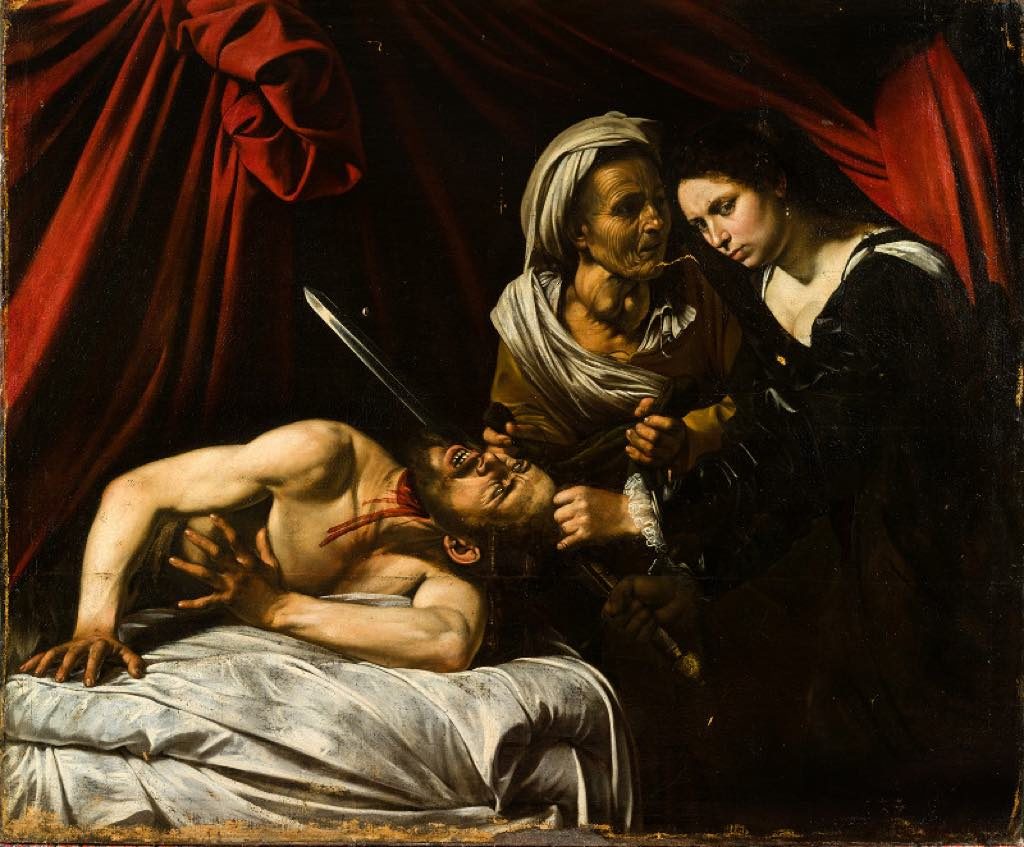
If nothing else, it’s a great story: in 2014, a man in Toulouse, France, is cleaning out his attic and comes across a dirty old painting with rather gory subject matter: a young woman is caught in the act of slicing off the head of a naked man. He calls a local auctioneer, Marc Labarbe, who comes to take a look and is impressed by the painting in spite of a white mist covering it that obscures the details.
He calls in Old Master expert Éric Turquin, who is based in Paris. A suspicion dawns in his mind, but he doesn’t say anything right away. He takes it away to be cleaned. His suspicion grows, and he finally tells the owner: this may be “Judith and Holofernes,” a missing painting by the great Caravaggio.
Experts are called in. Scientific tests are conducted. Extensive historical research is done. Five years pass.
Today, Old Master expert Éric Turquin is certain: this is a lost painting made by the master of chiaroscuro, probably in 1607. It matches an acknowledged copy of a painting known to have existed. The canvas and paint used to make it correspond to what was available at the time in Naples, where Caravaggio had fled to avoid a murder charge in Rome. It has been authenticated by a number of experts, including Keith Christiansen, John Pope-Hennessy Chairman of European Paintings at the Metropolitan Museum of Art in New York; Nicola Spinosa, former director of the Capodimonte Museum in Naples; and Jean-Pierre Cuzin, former head curator of the Louvre’s painting department.
“Judith and Holofernes,” aka “The Toulouse Caravaggio,” will be auctioned by Labarbe on June 27, 2019, at 6pm at the Halle aux Grains in Toulouse, with an estimate of €100-€150 million. It is currently on show at the Galerie Kamel Mennour in Paris alongside a mirrored installation by Daniel Buren (Caravaggio meets contemporary art) through May 4. Prior to the auction, the painting will also be exhibited in New York in May and in Toulouse in June (click here for details).
Turquin gave a talk in front of the painting last week, and his enthusiasm was contagious as he laid out what he believes are the proofs that this is a real Caravaggio (presented in great detail on the official website).
Not everyone agrees with him, however. The positive identification of Old (or even not so old) Master paintings is always a sticky wicket, open to debate.
Turquin pointed out that many of the journalists who deny the painting’s authenticity have not even seen it. I am by no means an expert on the subject, but I have seen the painting and might as well throw in my two cents.
In my very humble opinion, the figure of Judith, with its sensitive expression, could easily have been painted by Caravaggio, as well as such amazing details as the red draperies overhead, which form a theatrical setting for this most dramatic scene, and the sheets Holofernes lies on – who else would have paid such attention to the particular way they are tucked into the mattress and are pulling away from it under the weight of the screaming man?
But then there is the face of Abra, the servant who stands between Judith and her victim (capsule summary of the story: Judith has seduced the enemy general Holofernes, who is besieging her city, and gotten him drunk so she can murder him and thus save not only her city but Judaism as a whole).
To my eye, the servant’s face, with its encircling wrinkles, is just too crudely painted to be by Caravaggio. I felt the same way about Holofernes’ dirty chicklet teeth, painted without refinement.
I asked Turquin about the way the blood spurted straight out from Holofernes’ sliced neck, defying gravity. He told me that a surgeon who had attended one of his talks had said that that was exactly what would happen when the carotid artery is cut, and that the folds around the cut were also accurate. Turquin added that artists at the time often attended executions to observe the effect on the human body.
That explains why the blood is spurting straight out but not why it is painted so thinly and unconvincingly.
Is it possible that another artist had a hand in the painting?
In the end, the market will decide at the auction, but the skeptics will remain skeptical. That may change in time, however. Many other “lost” Caravaggios that were considered fakes or copies when they first turned up are now considered to be the real deal, among them “Salome Receives the Head of John the Baptist,” at the National Gallery in London, and “The Denial of Saint Peter,” at the Metropolitan Museum of Art
Go see the painting for yourself and make up your own mind.
Note: “Judith and Holofernes” was sold privately to American collector J. Tomilson Hill for an undisclosed price in June a few days before it was to be auctioned off.
Favorite
It has all the attributes of a laboured copy of a Caravaggio. Certainly not good enough quality and depth for Finson. Simply regard the “wrinkles” of the face of the old lady. These should resemble the furrow of a ploughed field. You should be able to put the edge of your finger in any of them. Here they are flat and comical, like a child’s face-painting. It would not have been possible for a master like Caravaggio to paint this badly. What is the buyer actually buying? Little more than a gruesome flat painting.
PS I’m sure The Louvre is not in the habit of “passing” on real Caravaggios. Nor would the French State allow free movement of this work.
It is, of course, a fun story for the summer, with accompanying publicity for all concerned. As a famous(sadly recently demised) quiz show host used to say-“Good game, good game.”